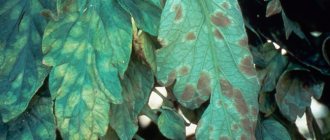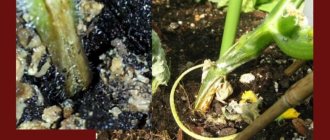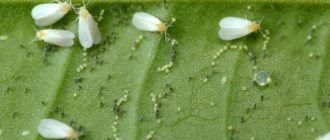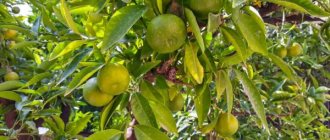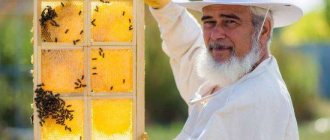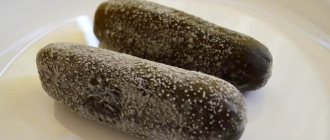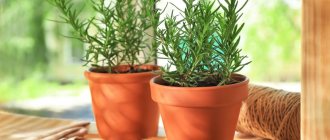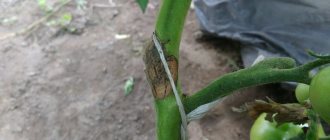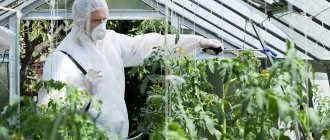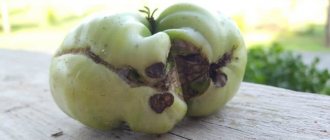Powdery mildew
The appearance of powdery mildew on pumpkin plants can be identified by white stains. They are circular in shape and form on the leaves, stem and petioles. If the parasite remains on the crop for a long time, individual spots merge into one large one. In this case, a white coating forms, which spreads over the entire sheet.
After some time, the affected parts of the crop turn yellow and dry out. The presence of spores negatively affects the quality of shoots and reduces its yield. When a gardener encounters a similar phenomenon, he wonders what caused the pumpkin to become infected with powdery mildew. The causative agent of the disease is a fungus.
Being a parasite on the pumpkin, it sucks out the beneficial substances from the plant. The vegetable needs them and, without receiving it, dries out. During the course of the disease within the crop, photosynthesis processes stop, which provokes the appearance of a yellow color on the leaves and other parts of the plant.
With powdery mildew, a fruiting body forms on the leaves. Thanks to it, the infection further spreads to other healthy parts of the pumpkin.
Control measures for the appearance of powdery mildew include treating the crop with special preparations. They can be purchased at a specialty store. If the lesion affects some leaves, they are removed. The cut areas should be treated with a solution based on mullein or ground sulfur. The plant cannot be saved when the fungus has spread to all parts.
Symptoms and what they mean
Spots, pustules, plaque - all these signs indicate that the vegetable is experiencing a lack or excess of nutrition or care.
Let's look at common symptoms that signal the onset of disease:
- White spots or white coating are a sign of an excess of fertilizers, especially mineral ones. Powdery mildew or fusarium wilt occurs as a result of the spots.
- The bushes wither due to sudden climate changes and non-compliance with crop rotation rules. The most likely diseases with such symptoms are root rot and verdigris.
- Fruit deformation is the main symptom of bacteriosis. The fruits take on a diseased form uncharacteristic for the variety and become weak and soft.
- Mold on the fruit indicates that the plant is experiencing an excess of moisture. A defect appears due to green or brown spotting.
- Yellow patterns on the leaves are the main feature of a yellow mosaic. If detected, it is necessary to treat the pumpkin with Bordeaux mixture or ash solution. Photos of diseased leaves clearly demonstrate the external signs of the disease. (photo 4)
- Pustules on the roots indicate that the plant is sick with root rot or fusarium wilt. This happens due to improper disinfection of seeds and soil.
Downy mildew or downy mildew
An inexperienced gardener may mistake the disease for powdery mildew. They look similar. You can tell that a pumpkin is suffering from peronosporosis by its gray coating, which has a purple tint. Characterized by its appearance on the inside of leaves.
The outside of the leaves are covered with yellow spots, which darken after a few days. They lose juice, so they dry out and break easily. The disease develops faster if there is high humidity outside. In this case, temperature also plays an important role; values within +16…+22 °C are especially dangerous.
As the air temperature rises, an interesting phenomenon occurs. When the pointer on the thermometer reaches +30 °C, the signs of the disease disappear. But this is a feature of the disease that every person involved in growing vegetable crops should know about.
After precipitation in the form of fog or rain, downy mildew attacks pumpkin plants with renewed vigor. It is imperative to take this nuance into account if downy mildew has been noticed in pumpkin beds. At the same time, their treatment is urgently carried out. To prepare the solution, you need to take 10 liters of water and dilute 35 g of copper oxychloride in it. Spray not only the affected parts of the pumpkin, but also healthy ones.
Pests threatening the pumpkin crop
Not only diseases can destroy a pumpkin. Another main enemy of vegetables is pests. Every year, thousands of summer residents lose a large percentage of their harvest because of them. To be able to fight pests, you need to find out who exactly is harming the melon crop:
- Melon aphid. She is used to settling at the very bottom of the leaves that sprout on pumpkin shoots. Aphids also attack flowers and buds. The pest can be detected by a number of signs. An infected plant will lose its inflorescences and the leaves will curl. The melon aphid does not allow the pumpkin to develop normally, which is why it reduces the yield several times.
- Spider mite. A big problem for all summer residents. Such insects are almost impossible to notice with the naked eye. Their presence is indicated by small cobwebs that appear on plants. Another obvious sign is yellow dots on the pumpkin leaves. Over time, they begin to lose vitality and moisture. The more mites that sit on a plant, the sooner it will die.
- Sprout fly. Another pest that threatens pumpkin. The larvae of this fly make their way straight into the stem without difficulty. There they live and eat. The larvae destroy the plant. They prevent pumpkin seedlings from developing.
Pests can be expected at any time. They often infect the crop during the germination of the first crops in the garden.
Sprout fly destroys pumpkin seedlings
Anthracnose
Among the main signs of the disease are round yellow-brown spots. At first they remain on the plant, and after a while they turn pink. If the infection is severe, the disease affects the root system and the pumpkin dies. The fruits of the crop, collected from diseased bushes, cannot be eaten, as they are bitter.
See also
Characteristics of healthy Hazelnut pumpkin, growing methods and care rules
Read
At the slightest sign of anthracnose, the plant is treated, and in the case of complete infection, it is destroyed and removed from the garden. Anthracnose can be introduced into the site along with contaminated seed material. To avoid this, it is necessary to take preventive measures. Before sowing, pumpkin seeds are processed and completely dried.
Wood ash is used to combat it. You need to dilute 40 g of ash in 2 liters of warm water and leave to infuse in a dark place. After a day, immerse the seeds for planting in liquid for 6 hours. After drying, they become suitable for planting. To prevent the development of anthracnose, it is forbidden to plant pumpkin after zucchini or melon crops.
If the plants in the areas were treated after anthracnose, it is not recommended to replant the pumpkin in the same place.
Disease Control
A set of preventive measures helps protect most plants, but there may be individual specimens that are still affected by the pathogen. The fight against the emerging disease should be carried out using several methods:
- Mechanical. Removing affected plants, cleaning up plants that thicken crops and prevent good ventilation;
- Chemical. Treatment with drugs;
- Biological. Preparations containing strains of beneficial microorganisms.
With a small lesion, in the early stages of the development of most diseases, it is enough to remove the affected parts or the entire plant and carry out preventive treatment.
At the first signs of powdery mildew, it is recommended to use the preparations “Karatan”, “Strobe” or “Topaz”. The last 2 are quite effective even with severe damage.
Peronosporosis can be treated with the help of copper oxychloride, as well as the drugs “Strobi”, “Kartotsid” and “Kuproksat”. If the disease occurs during fruit formation, it is recommended to use a 1% solution of Bordeaux mixture, which is also effective in combating anthracnose and bacteriosis.
Crops with a long period of fruit ripening, such as pumpkin, watermelon, melon, can be processed no later than 20 days before harvesting, although in small garden plots where the number of plants is not large, it is also worth giving preference to biological and folk remedies.
Bacteriosis
This disease is the most dangerous among all, as it causes the greatest harm to the culture. The appearance of the disease is noticeable by the appearance of the leaves. They are covered with angular brown spots. On the cotyledons, ulcers of the same brown color are noticeable. With bacteriosis, the fruits become covered with brown ulcers, which interferes with their normal development.
The initial stage of the disease is characterized by dark green spots. They can be seen early in the morning. Over time, the color changes to brown. In turn, this leads to drying out. Parasitism on fruits causes them to become ugly as they change shape.
Infected pumpkin leaves resemble a network of veins. In this case, the holes are not round, but have ragged edges. Bacteriosis tends to persist on seeds and crop residues. The development of the disease is facilitated by sudden changes in temperature at night. High air and soil humidity can provoke a wave of bacteriosis.
Seeds and green mass of the plant cannot be left on the land, as they remain sources of infection. The disease is easily transmitted by fabric, insects and water. If the disease cannot be avoided, copper oxychloride or Bordeaux mixture will help in the fight. Seeds must be treated with zinc sulfate before sowing.
If most of the crop is contaminated, it is completely destroyed. An excellent prevention that allows you to save pumpkin from bacteriosis is to follow the principles of crop rotation. Any plants that are part of the Pumpkin family are prohibited from being planted in the same place more than once every 3 years. Frequently changing the seat will help avoid bacteriosis.
Pumpkin diseases and their treatment
Pumpkin is immune to phytoinfections, and it does not get sick very often. But you need to know the signs of possible diseases and methods of control in order to react in time and not lose the harvest. Most often, the crop suffers from bacteriosis, powdery mildew, white and root rot, anthracnose, and yellow mosaic.
Bacteriosis
The disease begins to appear as dark green spots located between the veins of the leaves and having an irregular angular shape. On the underside, the formations have an oily structure. Over time, the affected areas become brownish-brown in color, then dry out completely. Dried fragments fall out and irregularly shaped holes remain on the leaf plates.
Due to bacteriosis, pumpkin leaves become covered with spots, which then dry out and fall out, forming holes.
Foci of infection prevent the fruits from developing, leading to various distortions and defects. In rainy weather, rot can completely destroy them. High soil and air humidity, sudden temperature changes (for example, a large difference between day and night values) contribute to the rapid development of bacteriosis.
Control measures:
- To combat an already manifested disease, treatment with Bordeaux mixture (1%) or copper oxychloride (0.4%) is effective.
- It is necessary to disinfect seeds before sowing using zinc sulfate (0.02%).
- Infected plants should be destroyed.
- It is necessary to follow the principles of crop rotation, which include the need to change the place where pumpkin crops are planted and not plant them in the same area more than once every 3-4 years.
The infection is spread by insects, birds, wind, and raindrops. It persists for quite a long time on plant residues and seed material.
Powdery mildew
First, small whitish round spots appear on the surface of the leaves, which then grow and cover the entire blade with a white coating. Petioles and stems are also affected. The fungus sucks nutrients from the plant. The leaves gradually dry out. Disorder of the photosynthesis process leads to late setting of pumpkin fruits; they are often deformed and have a poor taste.
With severe infection, fruiting bodies are formed on the leaves - cleistothecia, in which fungal spores form.
A clear sign of powdery mildew is a white coating on the leaves.
Fungal spores persist on weeds and plant debris. They are carried by the wind and on equipment. The disease progresses especially well with poor and untimely watering, as well as with an excess of nitrogenous fertilizers.
Experienced gardeners recommend choosing pumpkin varieties that are resistant to this disease.
During the growing season, weeds must be removed periodically. And after harvesting, it is necessary to immediately destroy all tops and plant waste.
Control measures:
- Affected plants are sprayed with a solution prepared on the basis of colloidal sulfur (70% paste or 80% granules are used). For open ground, the composition is prepared from 20 g of the substance per bucket of water, for closed ground (greenhouses) - 40 g per bucket.
- Treatments with sodium phosphate are possible (50 g of the substance dissolves in 10 liters of water).
- Treatments with infusion of fresh mullein are effective. It is filled with water in a ratio of 1:3, infused for 3 days, filtered, then diluted with water in the ratio: 3 liters of water per 1 liter of infusion.
- As a last resort, use the drug Topaz (according to the instructions).
White rot
All above-ground parts of the vegetable crop are covered with a characteristic whitish flaky coating, then dark round spots (sclerotia) appear. Infected areas soften and become slimy. Fruit-bearing plants are especially susceptible to this infection. The fruits die at the very beginning or, covered with spots, rot later. They may even look quite healthy, but they are completely unsuitable for storage, as they quickly decompose.
With white rot, infected areas of the leaf soften and become slimy.
The disease spreads successfully at high soil and ambient air humidity, as well as at low temperatures (12–15°C). Too dense planting also contributes to the development of infection.
Foliar feeding (spraying) is recommended as a preventive measure. 10 g of urea, 1 g of zinc sulfate, 2 g of copper sulfate are dissolved in a bucket of water.
Control measures:
- It is necessary to ensure good aeration of the plantings, remove lower leaves and weeds.
- At the end of the growing season, you need to burn the tops.
- Infected areas are sprinkled with crushed charcoal, chalk, ash or lime fluff.
- Plants are treated with copper sulfate (0.5%).
Root rot
An infectious fungal disease that affects the root system, in which the roots acquire a brownish-gray tint, crack and soften. The lowest leaves turn yellow and the plant stops developing. The infection usually affects weakened seedlings. The development of bacteria will be provoked by sudden temperature changes (night and day) and humidification with too cold water. In the end, if nothing is done, the plant dies.
Spores are stored in the soil and on undecomposed plant debris. Preventive measures include regular weeding and mowing of weeds, as well as watering with warm water (not lower than 20°C). It is useful to apply the fungicidal drug Previkur under the roots (dilute according to the instructions).
Control measures:
- Before planting, seeds are soaked in a 0.5% solution of copper salts or in a 0.25% solution of iron and boron compounds.
- When the very first signs of infection appear, it is necessary to remove the top layer of soil from the root collar and add fresh, uninfected soil (for the growth of new roots), peat, sawdust or sand.
- Stems, shoots and leaves are treated with ash, lime fluff, chalk or crushed coal.
- The root collar is sprayed with a 1% solution of Fundazol.
Anthracnose
The disease first manifests itself as brownish-yellow, rather large, spotted formations on the leaves, which then dry out and become colored. Later, signs of infection become noticeable on fruits and stems. They are black or brown ulcers with a pinkish coating. As a result, the plant dries out, the fruits wrinkle and gradually rot.
Anthracnose affects the leaves and fruits of pumpkin crops
Spores are spread by air, insects, and rain. For prevention, you need to treat the fruits with sulfur powder and destroy plant waste. For treatment, use 1% Bordeaux mixture or HOM (90% copper oxychloride).
You should be careful when harvesting and try not to damage the pumpkin skin, as fungal spores can penetrate through the defects.
Yellow mosaic
The disease is already noticeable on seedlings and young plants. The leaves show signs of chloroticity and spotting (mosaic). The leaf blades wrinkle and bend at the edges. Plants develop poorly and grow very slowly. The fruits are deformed and twisted, acquiring a mosaic coloring.
All melon and melon crops are affected by mosaic
Instances infected with yellow mosaic have low resistance. There is a very high risk of secondary infection, from which plants often die.
Control measures:
- As a preventive measure, seeds are soaked in a solution of potassium permanganate before planting.
- During the growing season, plantings are treated with the anti-fungal drug Farmayod-3 (the solution is prepared strictly according to the instructions).
- It is necessary to remove weeds and isolated diseased plants in a timely manner.
- It is recommended to protect the soil on the site with mulch, as well as treat healthy plants with an emulsion based on mineral oils.
White rot or sclerotinia
The disease is recognized by the appearance of a white coating. The structure resembles cotton wool, which is located on the fruits and at the base of the stem. The affected areas quickly lose their elasticity and become soft. Over time they rot. The best conditions for the disease are high humidity and low temperature. If the thermometer is from 10 to 15 °C, and the humidity reaches 90%, there is a threat of sclerotinia development.
In order not to fight white rot, it is necessary to follow preventive measures. To do this, regularly weed the land, prepare seed material before planting, and avoid re-growing pumpkins in the same bed. Sclerotinia loves cold and moisture, so it is forbidden to water the sprouts with cold water. At the 3-leaf stage, the crop should be sprayed with Bordeaux mixture. This will reduce the likelihood of white rot on pumpkins that develop in open soil.
Causes and risk factors
The causative agent of the disease is a fungal pathogen.
The infection most often comes from open ground, remnants of last year's tops, improper agricultural practices (cultivation of the soil), etc. Sharp temperature fluctuations and watering with cold water contribute to the strong spread of the disease. The disease actively develops in conditions of extreme heat and high humidity.
In greenhouse conditions, the cause of powdery mildew can be too infrequent ventilation, and stagnation of humid and warm air can also cause a surge and rapid spread of the disease.
Powdery mildew initially covers the leaf surface, then the entire plant, and then spreads to neighboring plantings. This leads not only to plant oppression, but also to poor flowering, fruit formation, and fruit quality. Because powdery mildew completely disrupts normal assimilation and transpiration processes. Productivity can decrease significantly - by 40 - 50%.
How to deal with aphids on pumpkins
Among the dangerous pests of pumpkins are aphids, which are transferred to the crop by weeds. The insect is small in size, and a person may not notice it on the leaves if there are few aphids. They are located on the bottom of the leaves and have a dark green color. The peak of parasitism occurs in mid-summer in open ground and in spring in greenhouses. The affected leaves of the crop curl as they lose juice, and over time the flowers die.
Advice! Aphids are afraid of ladybugs. It is recommended to collect a number of insects and release them onto pumpkin leaves. Over time, the ladybug will destroy the aphids. The insect perfectly protects the crop from pest attacks.
Treatment
To combat aphids, use a solution of karbofos. It is preferable to choose a concentration of 10%. You need to take 50 g of the substance per bucket of water. Spray the affected leaves using a special device.
See also
When to remove pumpkin from the garden for storage, timing of ripening in open ground and determination of ripeness
Read
Preventive measures
To prevent the spread of aphids throughout the entire plot of land, spraying is also used. Prepare the liquid yourself. To do this, you need to dissolve soap crumbs in a bucket of water or steam dried wormwood. This method is suitable not only for prevention, but can be a full-fledged treatment. You can get rid of midges by spraying the bushes with plain water.
The pressure washes away the aphids, and they are unable to climb back onto the pumpkin.
melon aphid
If yellow or green larvae and bugs with an oval body about a millimeter long appear on your pumpkins, these are melon aphids. We need to destroy it as soon as possible. Because at first your plants will be attacked only by wingless insects, and in the next generation females with wings will appear that will easily fly from one plant to another and destroy your crop.
The main place of settlement is on the back of the leaves. It happens that larvae appear in the ovary and flowers. The leaves on which the colony has settled quickly curl and wither. Flowers and ovaries also dry out. The pumpkin stops developing and dies.
Aphids, like the pumpkin diseases described above, appear due to weeds and the tops of cultivated plants that were not destroyed in the fall. Reproduces at incredible speed. Over the summer, 15 generations are hatched. Each female gives birth to at least 25 larvae.
How to fight aphids? Control methods are quite simple: removing weeds, spraying all grown plants with soapy water (200 grams of 72% laundry soap per 10 liters of warm water), populating the land with ladybugs. They feed on aphids. A decoction of wormwood destroys and repels aphids. If you spray your plants with it, the neighbor's aphids are unlikely to linger on your pumpkins. You can also treat it with a 10% karbofos solution if you don’t trust folk remedies.
Disease Prevention
Pumpkins can be affected by diseases and attacked by pests at any time. Bushes that are not properly cared for are especially susceptible. Improper watering, low temperatures and humidity provoke the appearance of the causative agent of many diseases - fungus. Prevention consists of the following measures:
- Deep plowing with the addition of fresh manure.
- Avoiding planting near melons.
- Collecting seed material from healthy crops.
- Removing weeds from beds.
- Preventing overly dense plantings.
- Before planting in open ground, seeds are treated. Regular potassium permanganate is suitable for this.
- Regularly inspect the crop for diseases and pests.
- To enhance the protective functions of the immune system, it is periodically fed. Urea, potassium permanganate, boric acid or copper sulfate are suitable as fertilizers.
- After harvesting, plant remains are collected and burned. Under no circumstances should wilted stems and leaves be left on the land. They can be infested with pests and diseases.
If you follow all agrotechnical measures, pumpkin diseases are something that people will not encounter. Crop rotation plays an important role. At the same time, monitor the frequency of planting. If a person follows the rules, the crop will delight you with a rich harvest.
Main diseases of pumpkin: signs, harmfulness and development conditions.
Large-fruited and nutmeg pumpkins have long won their place in vegetable gardens and fields, but in addition to traditional types, more exotic ones are also gaining popularity, such as bitter gourd (momordica), lagenaria, etc. Most pumpkin crops cannot be called sissies, because they withstand drought well, high temperatures and other weather extremes. However, extreme weather conditions and poor agricultural practices cause pumpkin diseases, which lead to a significant reduction in yield. That is why it is important to be able to recognize the early stages of disease development.
The Pumpkin family has a number of diseases that affect all members to a greater or lesser extent. They affect zucchini, squash, pumpkin, lagenaria, bitter gourd, cucumber and others.
Post navigation
We never deny ourselves the pleasure of annually setting aside a place in our dacha for planting such a tasty and healthy crop as pumpkin (here we talk about the actual cultivation of this vegetable). You can’t do without pickled pumpkin for the winter, not to mention a huge number of dishes made from it.
Pumpkin is a fairly resistant crop to external factors, but it is sometimes overcome by diseases and pests. Diseases such as rot and bacteriosis are very dangerous for the plant, but, to the delight of summer gardeners, pumpkin plantings are most often attacked by only two pests: melon aphids (they are also not a gift for cucumbers) and spider mites.
Tags: disease, pest, main, pumpkin About the author: admin4ik
